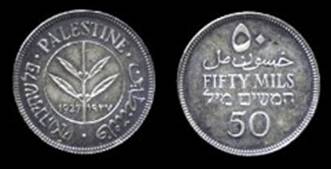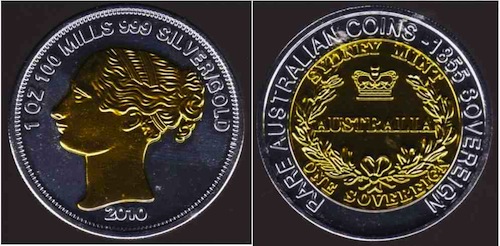A New One On Me - 100 Mills / 100 Mils Silver & Gold Ingots Available For Cents In The Dollar

As someone that is active on eBay as both a seller and buyer, I've seen enough "creative" marketing by less than scrupulous individuals to remain unsurprised by newer initiatives that are only ever about separating novice buyers from their money.
Although I've seen the terms "100 Mils" and "100 Mills" numerous times over the past few years, imprinted onto "art bars" and other ghastly reproductions aimed at impulse buyers of precious metals on eBay, I've never really given any thought as to what the term actually meant. As "mil" was a denomination used in Palestine under British rule from the 1920's to the 1940's, I presumed the manufacturer of the items in such advertisements had somehow appropriated the denomination to imply that their products had a legitimate face value, and as such weren't junk art bars after all.
It turns out I was completely wrong, and that the terms 100 mils / 100 mills and mills silver are all used to describe bars or ingots of metal that have simply been plated or "clad" (an interchangeable term primarily used in the US) in the precious metal they are advertised as being.
According to Wikipedia, the term "mil" is interchangeable with the term "thou" - a legitimate (albeit relatively obscure) unit of length measurement under the Imperial system. The article states that, a "thou" is "the verbalized abbreviation for 'thousandth(s) of an inch.' It is a unit of length equal to 0.001 inch." Each of the footnotes at the end of the Wikipoedia article confirm that attribution.
It makes perfect sense to me that a unit of measurement this small would be primarily used by tradesmen where specifications of tolerance are extremely important - engineers and machinists are most likely to use the term "thou" when measuring:
- The thickness of items such as paper, film, foil, wires, paint coatings, latex gloves, plastic sheeting, and fibres;
- Manufacturing dimensions and tolerances, such as in the manufacture of automobile engines;
- In the servicing of automobile engines (Typical examples include a spark-plug gap or ignition points gap.);
- In the manufacture of printed circuit boards (PCBs); and
- When measuring tolerance specifications on hydraulic cylinders.
As we operate on the metric system here in Australia, and the smallest (standard) unit of length measurement here is the millimetre (for which the verbalised abbreviation is also "mil"), I think most members of the Australian general public can be forgiven for not immediately knowing what the terms "mil" and "thou" actually refer to!
If we accept that under the metric system one "mil" is 0.0254mm or 25.4 microns, then a 100 mil plating is 2,540 microns or 2.54mm deep. Given the generally poor manufacturing quality of these products, I strongly doubt that - a few rough calculations show me that 100 mils is equivalent to around 20 pieces of 80gsm paper - stack them in front of you and I think you'll agree that these manufacturers would never go to that length (pun intended) to give a base metal bar the appearance of having been made from solid silver or gold.
Pure 99.9% Silver 100 Mils bar 1 Troy Ounce - A privately manufactured base metal ingot that has purportedly been (electro) plated in silver to a depth of 2.54mm. The total weight is purportedly 1 troy ounce - 31.1035g.
There are items advertised on eBay's Australian website at the moment that loosely fit this description - best thing to do is to steer well clear of them! Let's hope that these items are also banned from being sold under the new listing regime that begins on February 20th.
